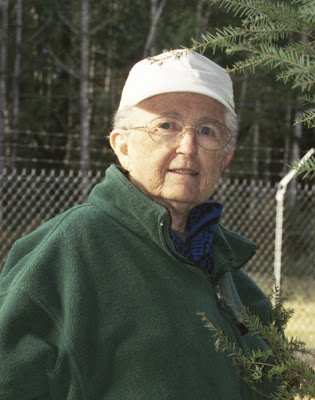by Amy Phan
August 5, 2011
POULSBO, WA — Jackie Hudson, a Poulsbo-based Dominican nun who spent decades demonstrating in support of nuclear disarmament, died at Harrison Medical Center on Wednesday. She was 76.
Hudson died from a type of blood cancer, according to the Kitsap County Coroner's Office.
She was diagnosed in June, said Sue Ablao, who has demonstrated in favor of nuclear disarmament with Hudson since the 1990s.
The two started managing and living at the Poulsbo-based peace organization Ground Zero for Nonviolent Action Center two years ago. The center organizes educational events and nonviolent protests focused on nuclear abolishment.
Hudson organized and led Ground Zero's nonviolent events, connecting with nuclear disarmament groups around the country.
Her activism landed her in federal prison three times, according to her brother, Frank Hudson.
"But I could not be prouder of her. I have always looked up to her and her stand on things and her willingness to put her life on it," Hudson said in a phone interview from his Michigan home.
The two grew up in a Catholic household in Central Michigan and attended Catholic schools.
Jackie Hudson surprised her family when she decided to become a Dominican nun when she turned 18. No one knew she was that serious, he said.
She received music training from the VanderCook College of Music in Chicago, then went on to teach music in her hometown for 30 years, Frank Hudson said.
During that time, her brother said, she began reading about global warming issues and learned how nuclear production contributed to the problem.
So she quit teaching music to participate in nuclear disarmament events in Michigan. Although small in size — Hudson was only 4 feet and 10 inches tall — she did not back down, her brother said.
In 1990 in Michigan, Hudson was sentenced to six months in jail for her involvement in a protest. In another Michigan incident, on an Easter Sunday, Hudson and other activists spray-painted "Christ lives, Disarm" on empty bunkers, according to Ablao.
"A lot of people respected her commitment and thoughtful concern on issues," Ablao said. "She was very action-oriented and at the same time, acted with deep discernment and thought."
Ablao has family in Bremerton, and she and Hudson decided to move there in 1993 after Wurtsmith Air Force Base in Michigan closed. Wurtsmith had been home to nuclear-armed B-52 bombers.
The two wanted to move to Bremerton because there was opportunity to continue their nuclear disarmament education, Ablao said.
Hudson found work as a driver for Kitsap Transit for about six years before she retired, according to Ablao.
The two continued to organize nuclear disarmament events out of their house until the Ground Zero Center building opened two years ago.
Hudson's cancer diagnosis came just weeks after her most recent run-in with the law.
In July 2010, Hudson and 13 other protesters trespassed onto Department of Energy property in Tennessee, gathered in a circle, prayed and sang. The group was charged with trespassing in May and was awaiting sentencing in prison when Hudson's health started deteriorating.
Authorities eventually dropped her charges and let Hudson return back to Poulsbo, according to Ablao.
Hudson's death comes within days of Ground Zero's events to commemorate World War II atomic bombings of Hiroshima and Nagasaki.
"Her death was a big shock to all of us. I think (her death) will renew and rededicate myself this weekend for this long struggle to abolish nuclear weapons," said Leonard Eigar, a Ground Zero member.
A celebration of Hudson's life is planned for 1:30 p.m. Aug. 13 at the Ground Zero Center in Poulsbo, located at 16159 Clear Creek Road NW.







